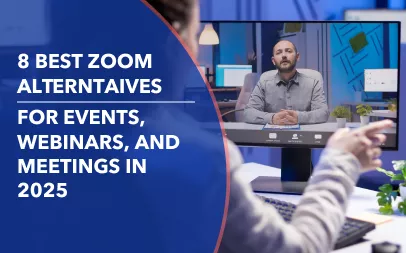
In the world of online education and business, webinars have become an essential tool for connecting with audiences. Whether you are hosting a webinar for educational purposes or promoting your products or services, one crucial factor that can influence the success of your webinar is the day and time you choose to host it. In this article, we will delve into the intricacies surrounding webinar timing and explore strategies to help you discover the best day to host your webinar.
Understanding the Importance of Timing in Webinars
When it comes to webinars, timing plays a critical role in attracting and retaining attendees. The right timing can ensure maximum participation, engagement, and the overall success of your webinar. By considering factors such as time zones, the day of the week, and even holidays and special events, you can optimize your webinar's timing and increase your chances of achieving your objectives.
The Role of Time Zones in Webinar Scheduling
With the global reach of webinars, taking time zones into account is crucial. Conducting thorough research on where your target audience resides and accommodating different time zones can help you cater to a broader audience and maximize attendance.
For example, if you are targeting an international audience, you may need to schedule your webinar at a time that is convenient for attendees in different regions. This means considering the time differences between countries and finding a time slot that works for everyone.
Tools like time zone converters can assist in determining the ideal time to schedule your webinar, ensuring that attendees from various locations can conveniently participate without any scheduling conflicts. These converters allow you to input your preferred time and location and then display the corresponding time in other time zones. This way, you can easily identify a time that aligns with the majority of your target audience.
How Day of the Week Affects Attendance
Another significant aspect to consider when deciding on the best day to host your webinar is the day of the week. Weekdays and weekends both have their merits, which can influence attendance rates.
Weekdays are generally when people are busy with work or other commitments. However, hosting a webinar on a weekday can also work in your favor, as professionals may be more inclined to attend events that align with their work schedule. By choosing a weekday, you can target professionals who are actively seeking educational or professional development opportunities.
On the other hand, weekends provide a more relaxed atmosphere, where individuals have more free time to engage in activities of their choice. Hosting a webinar on a weekend can attract a different audience segment, such as students, freelancers, or individuals who prefer to learn and engage outside of their regular work hours.
It's important to consider your target audience and their preferences when deciding between weekdays and weekends. Understanding their lifestyles and routines can help you determine which option will yield higher attendance and engagement.
In addition to time zones and the day of the week, it's also essential to take into account holidays and special events. These can significantly impact attendance rates, as people may have prior commitments or be away on vacation. By avoiding scheduling conflicts with major holidays or events, you can ensure that your webinar receives the attention it deserves and doesn't get overshadowed by competing activities.
Analyzing the Best Days for Webinars
When it comes to hosting webinars, one of the most important decisions you'll have to make is choosing the right day. The timing of your webinar can significantly impact its success and the level of engagement from your audience. In this article, we will explore the advantages and disadvantages of hosting webinars on weekdays versus weekends to help you make an informed decision.
The Case for Weekdays: Monday to Friday
Weekdays offer a more structured routine for professionals and students alike. By hosting your webinar on a weekday, you have the potential to attract a more engaged and focused audience. This is because people are already in work or study mode during weekdays, making it easier for them to allocate time for your webinar.
However, it is essential to consider potential conflicts that may arise when scheduling your webinar on weekdays. Work schedules, meetings, and school commitments can limit participants' availability, leading to lower attendance. To mitigate this, it is advisable to choose a time slot that aligns with common breaks or after-work hours, increasing the likelihood of participation.
The Argument for Weekends: Saturday and Sunday
On the other hand, weekends provide individuals with more flexibility and leisure time, allowing them to participate in webinars without competing obligations. This can be particularly beneficial if your target audience includes individuals who work full-time during weekdays. By scheduling your webinar on a weekend, you open up the opportunity for a wider range of participants.
However, it's important to strike a balance when considering weekends for your webinar. Weekends are also a time for relaxation, family activities, and personal commitments. If your webinar coincides with these activities, you may experience lower attendance rates. To overcome this challenge, choose a time slot that doesn't clash with popular weekend events or consider offering a recording of the webinar for those who couldn't attend live.
Ultimately, the decision of when to host your webinar depends on various factors, including your target audience, their availability, and the nature of your content. It's important to conduct research, survey your potential participants, and analyze past data to determine the optimal day and time for your webinar. By carefully considering the advantages and disadvantages of weekdays versus weekends, you can make an informed decision that maximizes attendance and engagement.
The Impact of Holidays and Special Events on Webinar Timing
When it comes to scheduling webinars, weekdays and weekends are not the only factors to consider. Holidays and other special events can have a significant impact on webinar attendance as well.
Navigating Public Holidays and Long Weekends
Public holidays and long weekends can either boost or hinder your webinar attendance, depending on how you plan around them. It is important to thoroughly research and consider these events before scheduling your webinar. Public holidays, for example, may provide individuals with more free time, increasing the likelihood of participation. People might be more inclined to join webinars during these periods when they have fewer work commitments. On the other hand, long weekends might tempt people to travel or engage in other recreational activities, potentially affecting attendance. It is crucial to take these factors into account and strategize accordingly.
For instance, if you are planning a webinar around a public holiday, you could emphasize the benefits of attending the webinar during this time. Highlight how participants can make the most of their free day by learning something new and valuable through your webinar. By positioning your webinar as a productive and enriching activity for the holiday, you may be able to attract a larger audience.
Scheduling Around Industry Events and Conferences
Industry events and conferences provide excellent opportunities to increase engagement and participation in your webinar. By aligning your webinar with these events, you can tap into an already captive audience interested in your niche. This can significantly boost attendance and enhance the overall impact of your webinar.
However, it is crucial to carefully select the timing of your webinar to avoid overlapping with competing events that may draw away potential attendees. Research the dates and schedules of other industry events and conferences to ensure that your webinar does not clash with them. By strategically planning your webinar around these events, you can maximize your reach and increase the chances of attracting a larger audience.
Furthermore, consider partnering with relevant industry events and conferences to promote your webinar. Collaborating with organizers or speakers can help you gain more exposure and credibility within your niche. This can lead to increased interest and attendance for your webinar.
Additionally, you can leverage the buzz and excitement surrounding industry events and conferences to create a sense of urgency for your webinar. Highlight how your webinar complements or builds upon the topics discussed at these events, making it a valuable follow-up or extension of the knowledge shared. By positioning your webinar as a must-attend event for those who want to delve deeper into the subject matter, you can generate more interest and attract a larger audience.
In conclusion, while weekdays and weekends are important considerations when scheduling webinars, holidays and special events can have a significant impact on attendance as well. By carefully navigating public holidays, long weekends, and industry events, you can strategically plan your webinar to attract a larger and more engaged audience.
Case Studies: Successful Webinar Timing in Practice
Examining real-world examples of high-attendance webinars and their schedules can provide valuable insights into effective webinar timing strategies.
A Look at High-Attendance Webinars and Their Schedules
Successful webinar organizers often conduct meticulous research and experimentation to identify the optimal timing for their target audience. By analyzing case studies of high-attendance webinars, you can gain inspiration and valuable takeaways to apply to your own webinar scheduling.
One such case study involves a software company that specializes in project management tools. They conducted a webinar on "Effective Project Management Techniques" that attracted over 500 attendees. The organizers meticulously researched their target audience, which consisted of project managers and team leaders from various industries. Based on their research, they discovered that the majority of their audience was located in different time zones across the world.
To accommodate their global audience, the webinar organizers decided to schedule the session at 10:00 AM GMT. This timing ensured that participants from different regions could join without facing any major time constraints. The organizers also took into consideration the average work schedules of their target audience and chose a weekday for the webinar, specifically Wednesday, to maximize attendance.
Another successful case study involves a marketing agency that specializes in social media advertising. They conducted a webinar on "Mastering Facebook Ads for Business Growth" that garnered a record-breaking attendance of over 1000 participants. The organizers recognized that their target audience consisted of business owners, marketing professionals, and entrepreneurs who were actively seeking ways to enhance their social media advertising skills.
After conducting surveys and analyzing data from previous webinars, the organizers discovered that their audience was most engaged during the late afternoon hours. Based on this insight, they scheduled the webinar at 4:00 PM local time, allowing participants to wrap up their workday and join the session without feeling rushed. Additionally, the organizers strategically chose a day towards the end of the workweek, Thursday, as research showed that people were more likely to have extra time and mental bandwidth to invest in professional development before the weekend.
Lessons from Low-Attendance Webinars and Their Timing Mistakes
Learning from mistakes is equally important in optimizing your webinar timing. By examining case studies of low-attendance webinars and pinpointing the timing mistakes made, you can avoid the same pitfalls and increase your chances of hosting a successful webinar.
One case study highlights a financial consulting firm that organized a webinar on "Investment Strategies for Wealth Creation." Unfortunately, the attendance was significantly lower than expected, with only 50 participants joining the session. Upon analyzing the timing, it was revealed that the webinar was scheduled during peak working hours, from 2:00 PM to 3:00 PM local time. This timing proved to be inconvenient for the target audience, which consisted of professionals and individuals with busy work schedules.
Another case study focuses on a health and wellness coach who conducted a webinar on "Achieving Work-Life Balance Through Mindfulness." Despite having a dedicated following on social media, the webinar only attracted 30 participants. The timing mistake in this case was scheduling the session late in the evening, at 8:00 PM local time. Many of the target audience members were already exhausted from their day and preferred to unwind rather than engage in a webinar at that hour.
These case studies emphasize the importance of understanding your target audience's preferences and constraints when determining webinar timing. By avoiding scheduling conflicts and considering factors such as time zones, work schedules, and audience engagement patterns, you can increase the likelihood of hosting a successful and well-attended webinar.
Tools and Techniques for Determining the Best Webinar Day
In the digital age, numerous tools and techniques are available to help you determine the best day to host your webinar. Leveraging these resources can provide valuable insights and data-driven decisions when it comes to webinar scheduling.
Utilizing Analytics for Webinar Scheduling
Webinar platforms often offer analytics features that provide valuable data on attendee behavior and preferences. By analyzing this data, you can identify patterns and trends that shed light on the most suitable day for hosting your webinar.
Surveying Your Audience for Optimal Timing
Directly engaging with your target audience by conducting surveys can be an effective way to gauge their availability and preferences. By asking specific questions related to webinar timing, you can gather valuable feedback that will guide you in making informed decisions.
Discovering the best day to host a webinar requires careful consideration of various factors. By understanding the importance of timing, analyzing the advantages of weekdays and weekends, and accounting for holidays and events, you can increase the effectiveness and reach of your webinars. Furthermore, studying successful and unsuccessful case studies and utilizing available tools and techniques will help you make data-driven decisions and optimize your webinar scheduling process. With the right timing, you can ensure maximum attendance, engagement, and overall success in achieving your webinar goals.
Like what you see?
Inspired to take your webinars and virtual events to the next level? Unlock the full potential with Remo's cutting-edge platform Elevate your gatherings with Remo's dynamic features. Sign up today and embark on a journey of unforgettable connections and growth! Book a demo today!




























